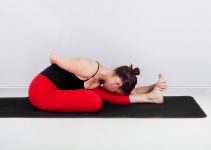- Swimming & Yoga
- When to do
- Down dog pose
- Up dog pose
- Eye of the needle pose
- Supine spinal twist
- Child’s pose
- Ujjayi Pranayama
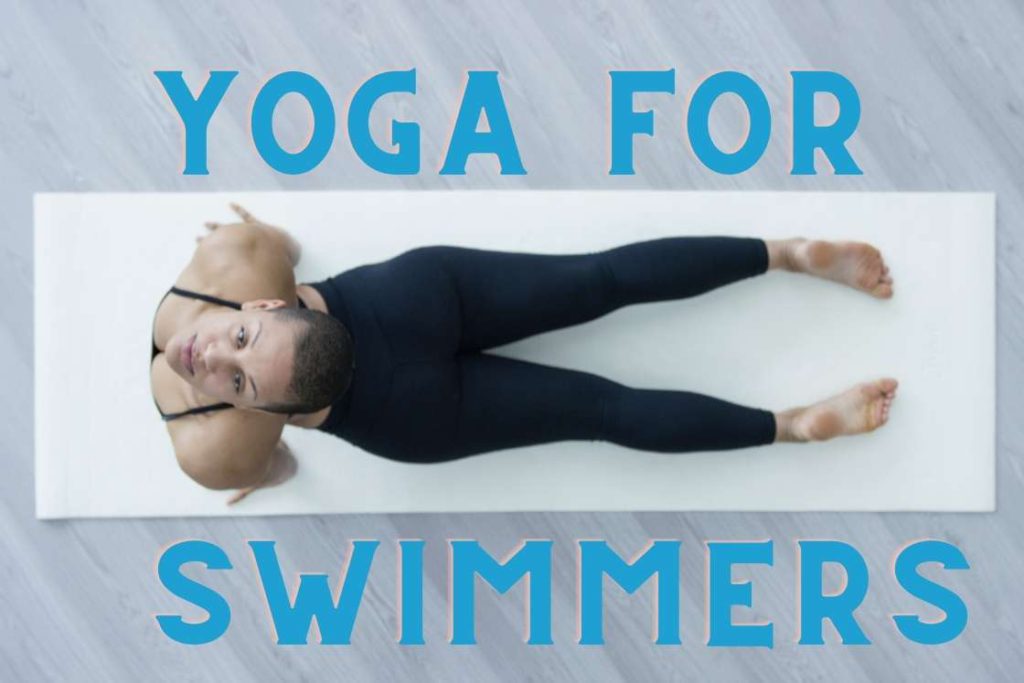
Yoga and swimming go hand in hand really. The way yoga can develop the upper body strength of a swimmer, create muscle depth in the back, and manage breath efficiency, makes both exercises a natural partner.
Yoga has a holistic approach that can make a swimmer’s dryland routine gentle on the injuries and creative on the range of motion. With such dynamic complementary benefits, yoga efficiently increases the strength and flexibility of a swimmer.
Tackle the strength of water with yoga
The main obstacle a swimmer faces is the resistance of water, which is over 700 times more than the resistance of air.
Thus, it is important for a swimmer to go well beyond practicing swimming, and focus on other specific exercises to deal with the resistance.
This is why dryland training is crucial to any swimmer. The main reason behind this dryland practice is to develop key muscle areas with exercises that are not core swimming exercises. This will help the muscles required in swimming, to develop a dynamic performance capacity and an injury-free nature.
End of the day, the dryland exercises aim at typical swimming functions. Which include explosive power in the water, swift cutting speed against the resistance of water, and a high stroke rate with increased distance per stroke rate. In short, you have to increase your physical mobility in water.
How Yoga Helps?
Yoga helps you develop your lats, triceps, pectoral muscles, shoulders, abs, and quads, which eventually helps you pack more power in the water. However, these muscles can be developed by a great many other dryland exercises. So why settle for yoga? Why is yoga a unique dryland exercise?
Yoga’s specialty is in its comprehensive approach. Yoga works not just on your muscles but brings a new range of motions to your joints. This makes your strokes and propulsion more dynamic while swimming.
Further yoga brings greater balance and body alignment, which with increased body awareness will help you improve your in-water postures and cut through the resistance efficiently.
And finally, yoga will enhance your cardiovascular and respiratory functions to make happen effective breathing while swimming.
When to do yoga for swimming?
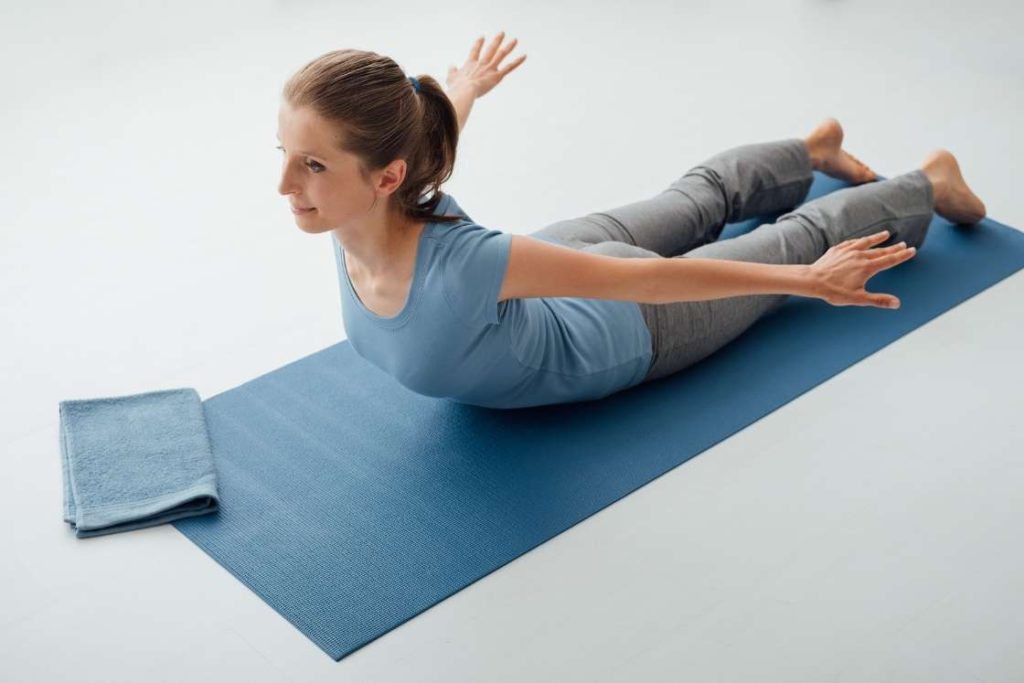
“Should I do yoga before or after swimming,” is a conflict to many, and rightly so. The timing of yoga is as important as the yoga itself. You must know that different yoga poses serve different purposes. Thus it is essential to figure the effect a particular yoga has on your body, and accordingly select a time of practice.
The Pranayamas that uplift your breathing and respiratory capacity can be practiced as a warm-up before swimming. Yoga involving mild stretching of your muscles can also be practiced as a warm-up. Mild stretches will loosen up your muscles, preparing you for a long haul in the waters.
Intensive strength and flexibility building yoga poses, on the other hand, cannot be included in the warm-up session. Neither you should practice such yoga poses after swimming. You need to have a sufficient rest period between strength-building yoga and swimming. The main reason being, both exercises are muscle intensive, causing wear and tear of tissues. Practicing these two exercises without a sufficient gap period can cause injury. The resting and relaxing yoga poses are a good choice for post swimming sessions.
Yoga Poses for Swimmers
Most yoga poses have a calming effect on the mind which will help an athlete’s mind free of distractions. Moreover, yoga poses can benefits different aspects of swimming, starting from muscles, to balance and body alignment to breathing.
Try these yoga poses to improve the swimming performance;
1. Downward facing dog pose (Adho Mukha Svanasana)
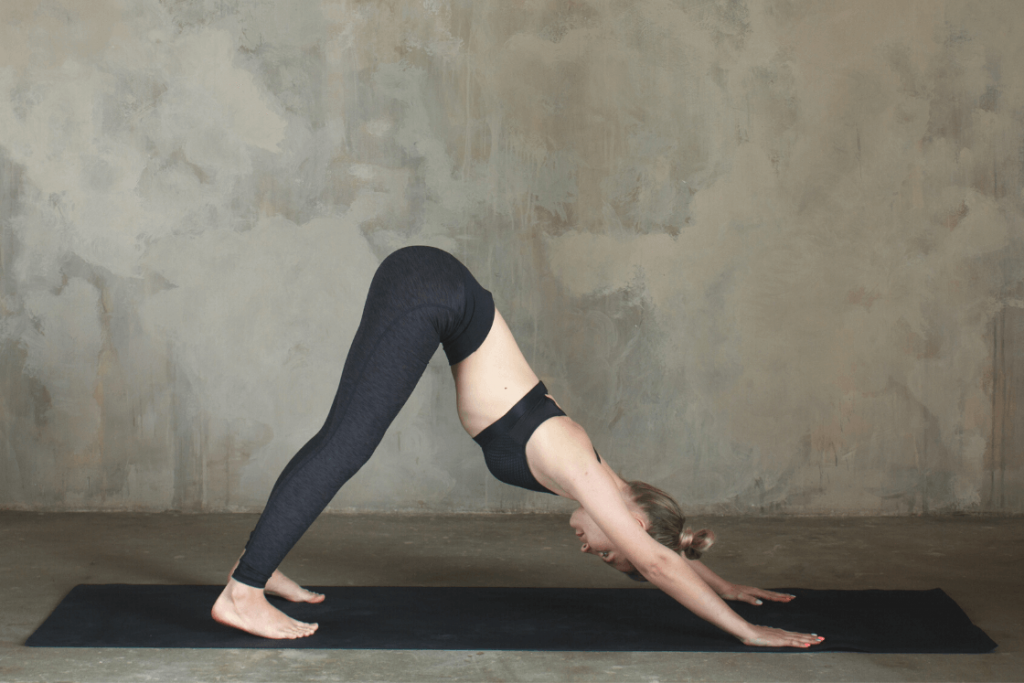
Downward facing dog is definitely one of the best stretches for swimmers. It will strengthen your back, shoulders, chest, triceps, calf muscles, quadriceps, and hamstrings. This pose will also increase the range of motion of your ankle and build a sense of body awareness. This increased body awareness will help you with your swimming postures.
- Get down on all fours, your hands, and knees. Keep your hands shoulder-width apart and knees hip-length apart. Ensure your wrists are exactly below your shoulders and knees below your hips.
- Now push with your hand against the floor, lift your knee and push upward and backward with your buttocks.
- Keep pushing upwards and backward, till your body makes an inverted V on the ground.
- Your upper body and hands should be completely stretched from your hips in a downward slant. And your legs too, stretched, with knees straight and heels pressed against the ground.
- You can hold this pose for 10 seconds or you can try and deepen the stretch by trying to push your hip further back and chest further down.
Note – You can include down-dog pose in your warmup swimming session, but in that case keep the stretch to a minimum. You don’t want to push your muscles to their maximum in the warm-up itself. Otherwise, include this pose in a session completely separate from your swimming practice, where you will be able to take the pose to your maximum stretch.
2. Upward facing dog pose (Urdhva Mukha Svanasana)
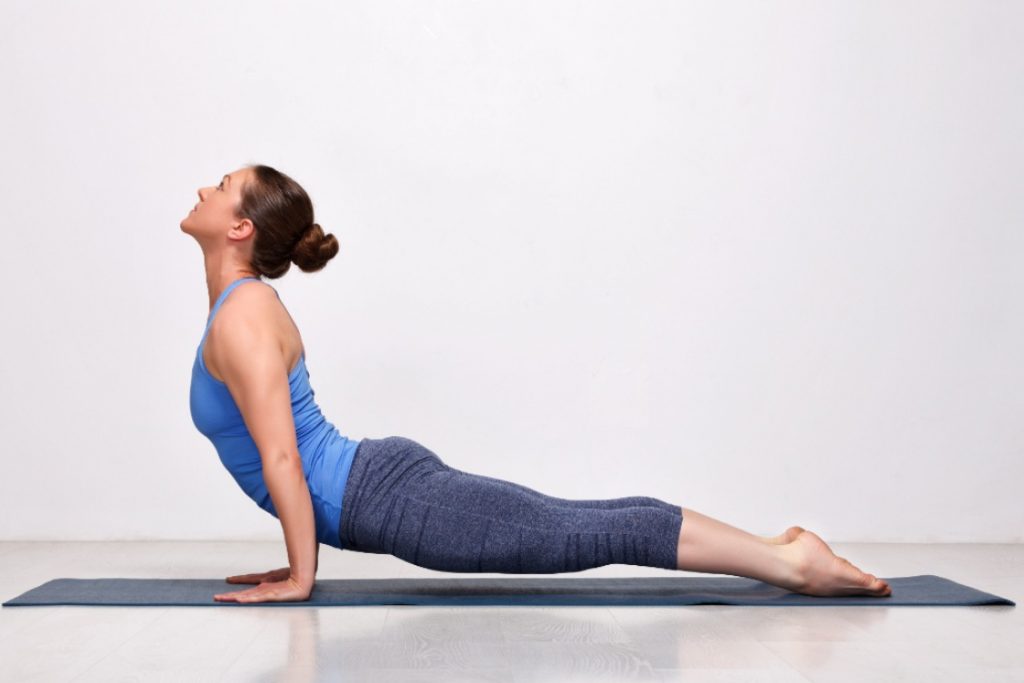
Equally beneficial to the downward-facing dog is the upward-facing dog. Especially, because of the influence it has on your essential lats. This yoga pose will build the muscle areas specific to swimming, in your upper body. This pose will stretch your spine to provide therapeutic relief of body aches associated with swimming.
- Get on all fours, make sure your hands are exactly below your shoulders and knees slightly behind your hips.
- Now gradually, come down to the floor, touch your chest and chin to the ground. Do not just fall on the floor, rather carry your weight down to the ground.
- Make sure your hands are slightly behind your chest. And your shoulders back; shoulder blades pressed together.
- Now push yourself up, and slowly straighten your hands. Do not squeeze your shoulders, rather keep them low, and push your chest upwards, and gradually arch your head back.
- Increase this arch just to the point where your knees get lifted from the ground. Hold your pose for a comfortable number of breaths and slowly release the pose and lie down on your front.
Note – Upward dog pose is a core strength and flexibility exercise, so must practice this in a completely separate session from your swimming. Also, while releasing this pose, as you lie on the front of your body, try instinctively pushing back into the child’s pose, hold it there for a couple of breaths, and then get up. This will help you avoid injury.
3. Eye of the needle pose (Sucirandhrasana)
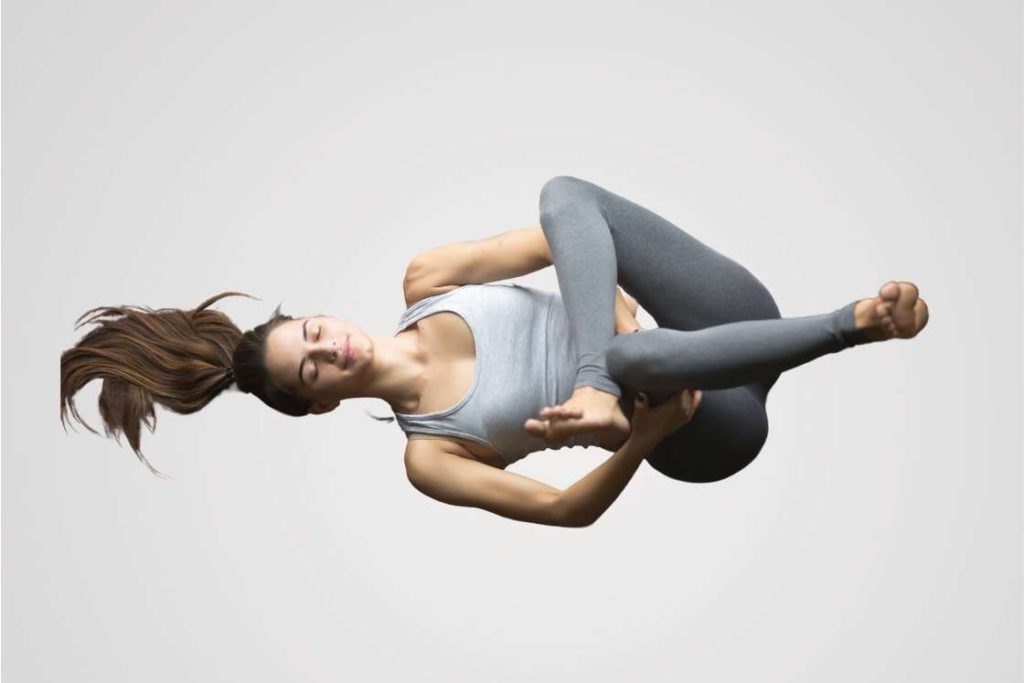
Legs are an important part of swimming and this pose is the right exercise for your leg muscles.
The eye of the needle pose graciously opens up the muscles in your lower back, hip, and upper legs. This is less of a strength-building yoga and for a flexibility-building yoga. And unlike, the previous two poses the eye of the needle can be a very good inclusion into your warm-up, for stretching your thighs, hips, and lower back before swimming. This pose will also strengthen and lengthen your lower back that will help you cover more distance per stroke.
- You lie on your back with your knees folded, feet touching the ground.
- Keep your upper body straight, like you would while standing erect. Do not let your spine take the shape of the floor. Especially, keep your lower back lifted from the ground.
- Now pull up your right leg and clasp your hands around the middle of the hamstring.
- Put left leg over your left hand and place your left ankle over your right knee.
- Now keeping your lower back lifted, press your right thigh against your hands, press your thigh as far away from your body as possible, without lifting your sitting bones. Feel the stretch in your lower back
- Now gradually, pull your legs toward your body, but not letting your lower back touch the ground. You will be help to feel the stretch in your hips.
- Repeat the pose on the other leg as well.
Note – You can do eye of needle pose both before and after swimming. Remember, while pulling the right leg towards your body, you need not bring it all the way down to your chest. That is not the target. Pulling it till your right knee is over your belly button, is sufficient. Over pulling your right leg can injure the side thigh muscle of your left leg.
4. Supine Spinal Twist (Supta Matsyendrasana)
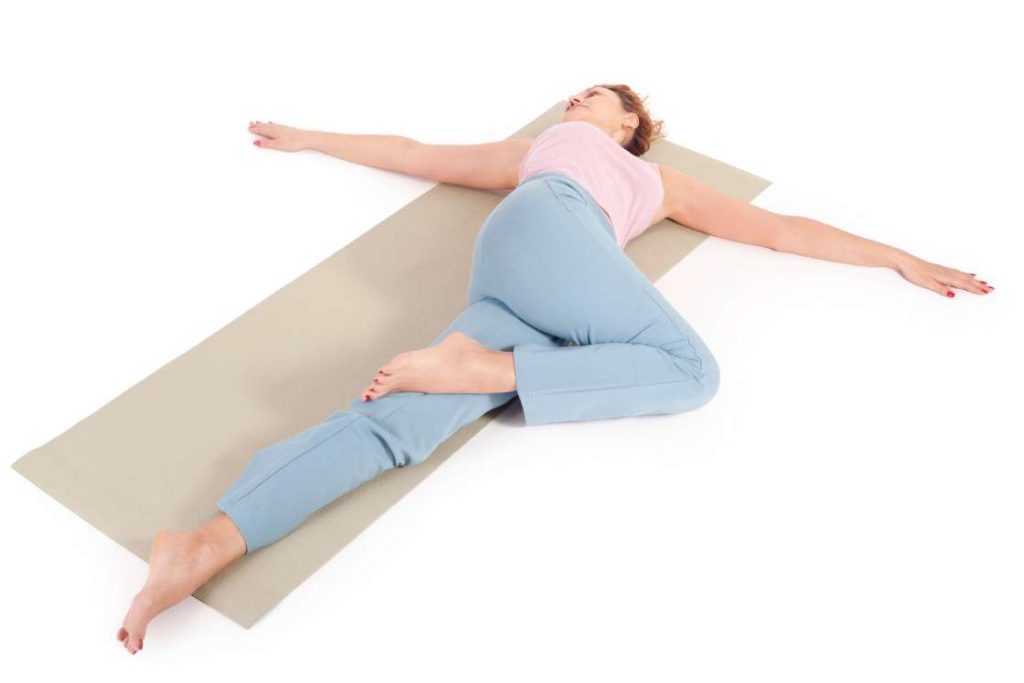
Supine spinal twist will most act as a healing and therapeutic relief exercise. The pose brings multiple benefits including, relaxing the stiff spine, hip, and lower back. The pose also removes toxins from your body and stretches your shoulders, upper back, and chest. At the day’s end, after rigorous swimming practice, the supine twist can be your go-to comfort pose.
- Lie supine on your back
- Bend your right knee and take your right leg over your left knee. Place your right foot outside your left knee, pressing your right heel against your left knee.
- Know use your left hand to apply pressure on your right knee and pull down the knee towards the ground. This will create the supine twist.
- Keep your right chest centered, and right arm and shoulder stretched out to the right.
- Keep pulling your right knee down very slowly, till the knee touches the ground creating maximum twist.
- Don’t forget to breathe into your spine.
- Hold your pose for 30 seconds and do the twist on the other side.
Note – You can try this pose post swimming or at the end of other dryland exercises. Remember as you make the twist, don’t force your right shoulder ( or the one on the opposite side of the twist,) to stick to the ground. It’s okay for it to come off the ground a bit. Just be conscious about it and don’t let your upper body turn.
5. Child’s pose (Balasana)
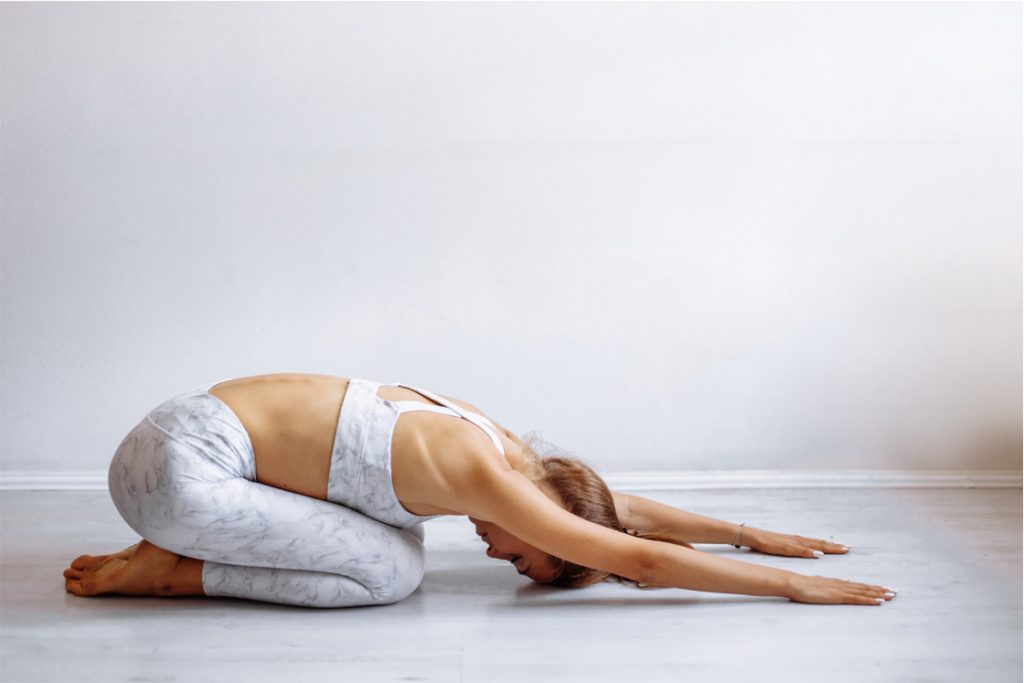
Child pose is largely known in the yoga world for its potential to relax your body and rid you of stress. However, in I case of swimming, child’s pose brings yet another benefit. It will develop strength and flexibility of a swimmer’s lat. This pose will also lengthen and stretch your upper back.
- Kneel down in your knees, and sit back on your heels.
- Now bring down your body completely, so that your chest rests on your knee and your head on the ground.
- Raise your hands and stretch them straight Infront of your head.
- Now open your shoulder blades, shoulders and upper and middle back, and stretch forward with your arms and upper body as much as possible.
- Breathe for 10 seconds, and breathe into your lower back.
- Repeat this exercise 3 times.
Note – Child’s pose can be done at the end of any exercise both pre and post swimming. Also while stretch remember to only put your upper back and arms at it. Keep your lower body fixed.
6. Ujjayi Pranayama
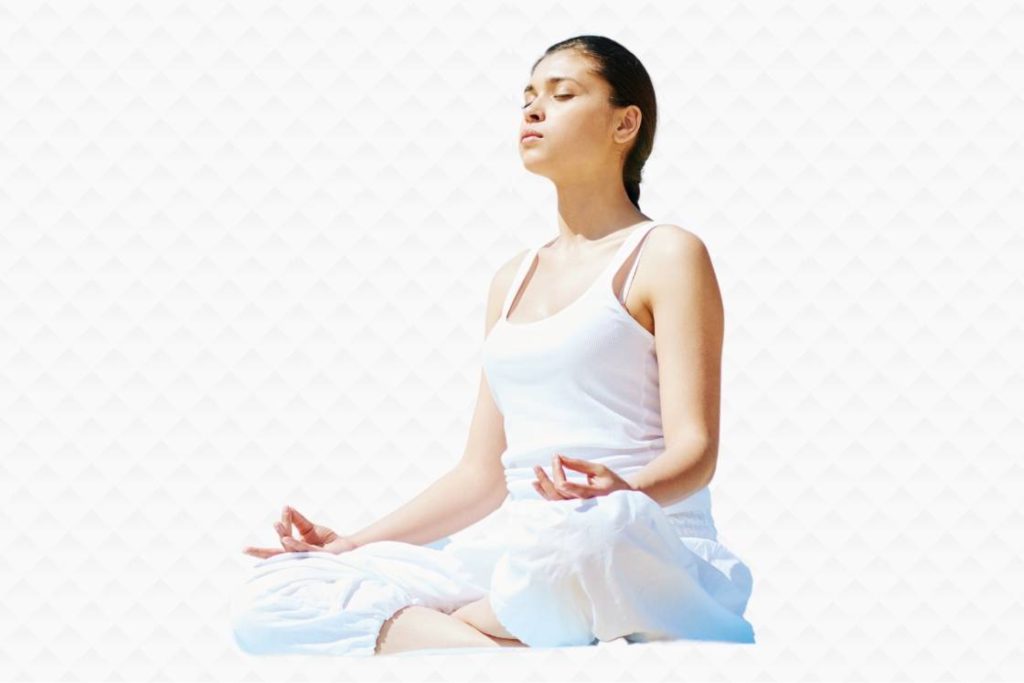
Breathing is a critical part of swimming, and as such, Ujjayi Pranayama will be a critical part of your dryland yoga exercise. This breathing exercise in case of swimming works solely to increase the capacity and functioning of your lungs. Practicing the breathing techniques of Ujjayini you will learn restricted breathing and get better control over exhaling.
- Sit in a comfortable cross-legged posture.
- Keep spine straight, shoulder blades open and head straight.
- Now Slightly tilt your head downward, constrict your throat to restrict all the passages, and inhale as deep as you can.
- Hold your breath for 10 seconds.
- Now close your right nostril and steadily exhale through your left. Lift your head straight while exhaling.
- Do 5-10 rounds of this Pranayama.
Note – The effects of this Pranayama are almost instantaneous. You can include this Pranayama in your swimming warm-up, or any early morning routine if you have any. Pranayamas are always best fitted early in the morning.
Conclusion
Swimming in itself is a wonderful exercise. Swimming, when combined with yoga can give you miraculous benefits; you will reach the pinnacle of athleticism. If you are someone who swims for relaxation and exercise, or someone who swims for competition, in either cases yoga will definitely boost your swimming.
There are multiple areas of swimming that yoga can enhance. With yoga, you can increase your strength and flexibility, the two fundamentals of swimming. Certain yoga practices can also enhance your breathing and reduce muscle fatigue; two factors that are equally important to strength and flexibility.
